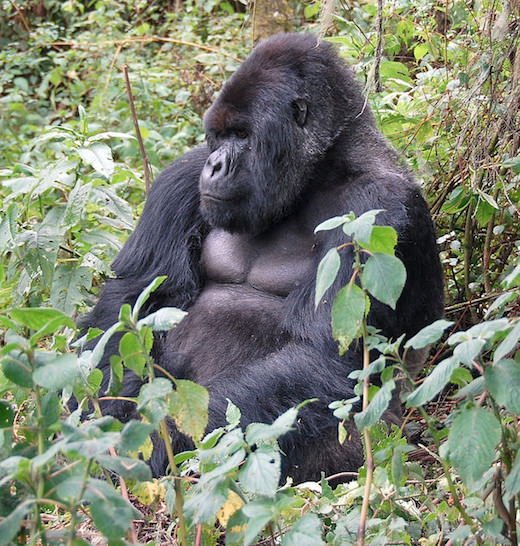Mountain Gorilla

Critically endangered
Found in the Virunga volcanic mountains of central Africa, the mountain gorilla has longer hair and shorter arms than its cousins living at lower elevations. Like most primates, the mountain gorilla is capable of scaling trees, however, the species spends the main part of its time at ground level where it lives in communal groups of anything up to 30 other individuals.
Lead by an alpha male usually termed a silver back due to silver hair which adorns his otherwise dark coat, mountain gorilla communities center around a complex social hierarchy. Occupying 2-40 square kilometer home ranges, it is the leader of a mountain gorilla troop who organises and overseas group activities such as eating, moving from one location to another and nesting in leaves come evening time.
Though vegetarian, the mountain gorilla is a very powerful creature and should any gorilla in a troop break ranks with the alpha male impressive displays of strength will follow. Such displays are however, usually just for display purposes only and the mountain gorilla is usually a calm creature unless disturbed or threatened.
Incredibly intelligent, captive mountain gorillas have been successfully taught to use human sign language to communicate, and mountain gorilla young often remind people of human children due to their exhibiting communal play, investigative learning and even mischief.
Population Distribution
The entire population of wild mountain gorillas resides in the Albertine Rift mountain forests which cover parts of Uganda, Rwanda, Burundi, Tanzania and the Democratic Republic of Congo, and the Virunga volcanic mountains which are a branch of the same area. Living at altitudes of anywhere between 2,000 and 4,000 meters, the most mountain gorilla population dense area is located in the Virunga mountains. At present there is believed to be a total wild population of 880 mountain gorillas, however, some primatologists believe that mountain gorillas found in Uganda may actually be a rarer subspecies.
Threats
Conservation efforts have in recent years seen a significant increase in wild mountain gorilla populations, however, the species is still considered critically endangered. Poaching is after all, still a leading cause of the mountain gorilla's overall decline. Kidnapped for sale to zoos and as exotic pets, killed for local bushmeat markets and even hunted so that their body parts can be sold as trophies to international collectors, Karisoke Research Center in Rwandas Volcanoes National Park employs guards to remove upwards of 1,000 illegal snares every year.
However, habitat loss is just as significant threat to the mountain gorilla. Like in many parts of the world, central Africa's dense forests are constantly being encroached upon by agricultural and urban development projects. Unlike in other areas though, such habitat loss is exasperated by war and unrest in the area. Refugees often deforest areas unofficially in order to clear space to create settlements. Likewise, displaced communities often resort to hunting mountain gorillas for nutritional purposes, whilst using slash and burn agriculture which destroys even further tracts of mountain gorilla habitat. Moreover, significant numbers of mountain gorillas are directly caught up in violence each year through being killed by mines laid on forest paths.